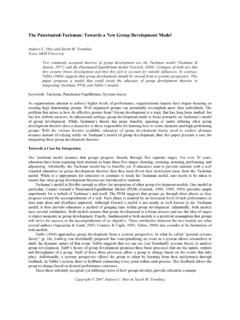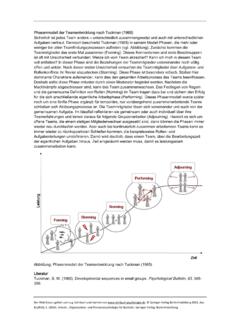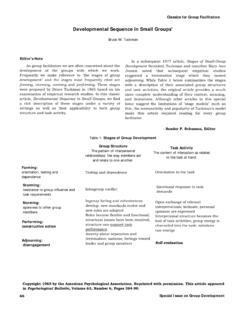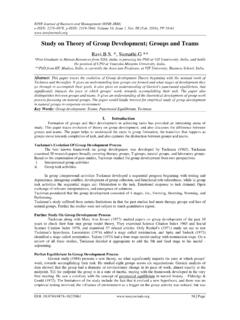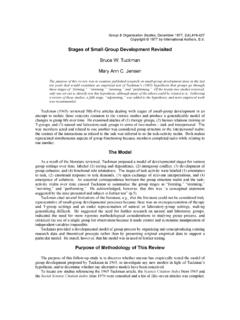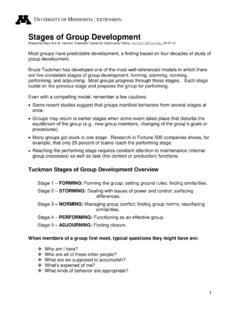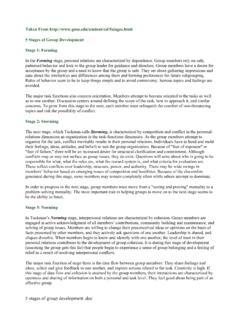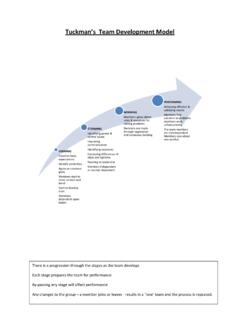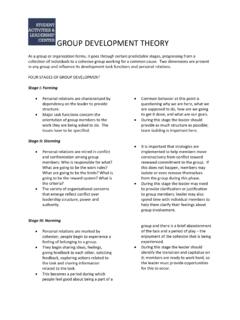Transcription of Unit 9: Team Building in Business
1 1 BTEC INTERNATIONAL Business UNIT 9: TEAM Building IN Business Pearson BTEC International Level 3 Qualifications in Business Delivery Guide Issue 2 February 2020 Pearson Education Limited 2020 Unit 9: Team Building in Business Delivery guidance Approaching the unit Learners will bring their knowledge of teams through their experiences in school or college, participation in sports or enterprise activities, or being part of a team in their part-time job or work experience. You should encourage learners to look at a variety of teams, and understand that they come in many forms and exist for many purposes.
2 They should become aware that if properly managed, teams can contribute to improved Business performance while helping to empower individuals, and improve job satisfaction and engagement. Not all teams succeed, however, as conflict can appear in team situations, and learners need to understand how conflict can be reduced. Learners must have plenty of opportunities to practise their skills across a range of team situations to show their knowledge and understanding of the unit. To complete this unit your learners will need access to a range of research materials, which could include the internet, journals or magazines, and books.
3 You can use a range of delivery methods in this unit, such as: discussions class and small group discussions on the differences between groups and teams, and team theory individual or group presentations covering characteristics of successful teams case studies illustrating teamwork in businesses media and journal articles relating to team work videos providing talks on teams. Group work is an acceptable form of delivery, but you must ensure that each learner produces their own evidence that is sufficient for assessment. You can involve local employers in the delivery of this unit by inviting them as: guest speakers providers of work experience for learners, and of Business materials as basis for case studies and exemplars mentors for learners.
4 2 BTEC INTERNATIONAL Business UNIT 9: TEAM Building IN Business Pearson BTEC International Level 3 Qualifications in Business Delivery Guide Issue 2 February 2020 Pearson Education Limited 2020 Delivering the learning aims For Learning aim A, it is important that learners understand the differences between a group and a team, and the factors that contribute to an effective team. You could ask learners to individually list different types of teams they have been a member of, in school or college, outside activities, or hobbies, then identify the purpose of the team and share these with the class.
5 Expand on the topic by having learners share stories about their experiences in and knowledge of different teams, and what they believe contributes to the success of a team. There are many short video clips on video-sharing websites that illustrate good and bad teamwork. Introduce a team game such as the marshmallow challenge, a simple team- Building exercise, to find who can build the tallest tower with dry spaghetti, masking tape and a marshmallow. You could then look at the short TED Talk video on Build a tower, build a team , which analyses how other people have performed in this challenge, and discuss as a class the differences between their experiences and these findings.
6 ( ), For Learning aim B, it is important that the learner understands the roles and dynamics of Business teams and is able to make recommendations to improve team cohesiveness. To illustrate examples of effective and ineffective teams you can again show short video clips. These can also be used to introduce the role of the team leader and introduce a discussion on how leaders contribute to the overall effectiveness of the team. You may also want to mention team work in sports such as formula 1 racing or cycling. Team members perform in a way that is best for the team overall. You can introduce the theory of Belbin Team Roles and tuckman s theory of team development through activities and games available online, and this can lead to discussions on why an effective team needs to have a mix of capabilities and not consist entirely of those with leadership skills.
7 Guest speakers could be invited from local and national businesses to talk about teams. Learners could be tasked with preparing suitable questions prior to the speaker s arrival on the subject of teams and how they have been successfully developed. This should ensure that learners are getting the most out of this activity. For Learning aim C, you should ensure that learners have plenty of opportunities to work in teams. Activities can be given to highlight the advantages and disadvantages of teamwork, including following instructions, dealing with difficult people, and an individual s own contribution to the team objectives.
8 Learners should take on both the role of the team member and the team leader. Learners should be encouraged to identify potential improvements in their own team working skills and techniques. At the end of a group activity learners should be asked to review how they performed and identify what they would do differently next time. Again, video clips can be used to reinforce examples of good and bad team working skills. Reflecting on their own effectiveness is a skilled task. Learners must be given a range of opportunities to test out their own skills as a team member and leader to help them to identify the key areas to review, and how they could evaluate the performance of the team and their own contribution.
9 3 BTEC INTERNATIONAL Business UNIT 9: TEAM Building IN Business Pearson BTEC International Level 3 Qualifications in Business Delivery Guide Issue 2 February 2020 Pearson Education Limited 2020 Learning aim Key content areas Recommended assessment approach A Examine the benefits of teams in a Business setting A1 The difference between a group and a team A report that examines teams in Business settings. It should consider types of teams and their purpose, and the benefits of these teams to the businesses. A report that examines the effectiveness of a real team in a Business setting.
10 It should reflect on team theories, and make recommendations for improvement to the team. A2 Types and purposes of Business teams A3 Characteristics and benefits of an effective team B Investigate techniques and theories used for the development of an effective Business team B1 Team- Building techniques B2 Theories of team development B3 Causes of team conflict C Develop effective team skills through practical activities C1 Being an effective team member C2 Being an effective team leader The evidence will focus on what went well and what did not in the team activities. Learners should evaluate and self-critique their performance in a team, the development of their skills, and evaluate the effectiveness of the team.










